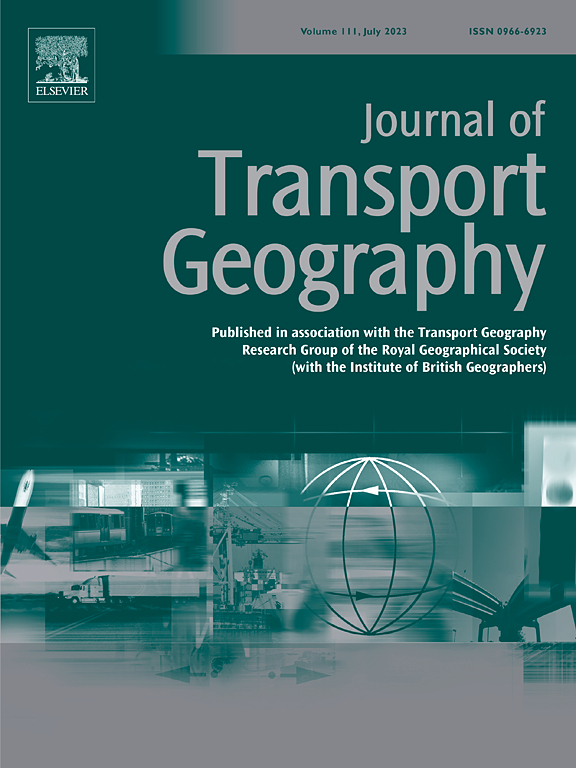在印度尼西亚巴厘岛,父母参与和性别对上学出行方式决定的作用
IF 5.7
2区 工程技术
Q1 ECONOMICS
引用次数: 0
摘要
青春期的特点是探索、冒险行为和特定性别的挑战,这往往涉及父母参与出行决策。本研究通过分析印度尼西亚巴厘岛 2402 名 12-18 岁青少年的数据,探讨了父母影响、性别和出行方式选择在塑造学校出行行为方面的相互作用。研究采用了解释性因子分析(EFA)来确定与旅行态度相关的潜在结构,并估算了多项式对数(MNL)模型,以分析选择不同旅行方式的概率,同时考虑到父母参与、性别和其他个人层面的特征。研究结果表明,年级、性别、学校位置、出行方式、父母的就业状况、家庭收入和父母的参与程度都会影响出行方式的选择。大多数青少年(55.62%)与父母共同做出出行决定,初中阶段父母的影响更大。尽管认为摩托车不如其他交通工具安全,但高中生更倾向于使用这些私家车。尤其是男生,他们更喜欢摩托车,因为摩托车能说服家长允许他们使用,特别是在社会对未成年人驾车的压力较小的地区。与此相反,女生更倾向于在护送人员的陪同下出行,这与家长避免不安全使用摩托车的偏好一致。此外,当父母是主要决策者时,出行选择上的性别差异就会缩小,因为安全问题会优先考虑,从而阻碍私家车的使用。这些发现强调了执行法定驾驶年龄限制的必要性,尤其是在向高中过渡期间。要解决这一问题,需要协调交通和学校政策,加强交通执法,提供更安全的出行选择,确保学校路线安全,并加强家长监督。本文章由计算机程序翻译,如有差异,请以英文原文为准。
The role of parental involvement and gender on travel mode decisions to School in Bali, Indonesia
Adolescence is marked by exploratory, risk-taking behaviours and gender-specific challenges that often involve parental involvement in travel decisions. This study examines the interplay between parental influence, gender, and travel mode choice in shaping school travel behaviours by analysing data from 2402 adolescents aged 12–18 in Bali, Indonesia. Explanatory factor analysis (EFA) was used to identify underlying latent constructs related to travel attitudes, and a multinomial logit (MNL) model was estimated to analyse the probability of choosing different travel modes while accounting for parental involvement, gender, and other individual-level characteristics. The findings show that grade, gender, school location, mode availability, parents' employment status, family income, and parental involvement influence travel mode decisions. The majority (55.62 %) of adolescents make travel decisions jointly with parents, with parental influence being more substantial in junior high school. Despite perceiving motorcycles as less safe than other modes, senior high school students are more likely to use these private vehicles. In particular, Boys prefer motorcycles as they are persuasive in convincing parents to grant them access, especially in areas with little societal pressure against underage driving. In contrast, girls are more likely to be escorted, aligning with parental preferences to avoid unsafe motorcycle use. Moreover, when parents are the primary decision-makers, gender differences in travel choices diminish as safety concerns take precedence, discouraging private vehicle use. These findings underscore the need for enforcing legal driving age limits, particularly during the transition to senior high school. Addressing this issue requires harmonising transport and school policies, strengthening traffic law enforcement, providing safer travel alternatives, ensuring secure school routes, and increasing parental oversight.
求助全文
通过发布文献求助,成功后即可免费获取论文全文。
去求助
来源期刊

Journal of Transport Geography
Multiple-
CiteScore
11.50
自引率
11.50%
发文量
197
期刊介绍:
A major resurgence has occurred in transport geography in the wake of political and policy changes, huge transport infrastructure projects and responses to urban traffic congestion. The Journal of Transport Geography provides a central focus for developments in this rapidly expanding sub-discipline.
 求助内容:
求助内容: 应助结果提醒方式:
应助结果提醒方式:


